Leading Suppliers Announce The Future of Automotive Electronic Systems
From driver assist to crash avoidance, vehicles are getting smarter and safer with growing help from on-board electronics
2013/04/10 | By Quincy LiangAutomotive electronic systems are making modern cars more comfortable, powerful, connected and safer. Global Tier-1 auto component suppliers are driving this trend forward through intensive development and innovation that is bringing these systems to a whole new level.
Many key global players announced new products, technologies, mergers and acquisitions, or forecasts before and during the 2013 North American International Auto Show (NAIAS) held in mid-January in Detroit. These announcements offer a peek at where automotive electronic systems are heading for new-car models to be unveiled by global automakers over next few years.
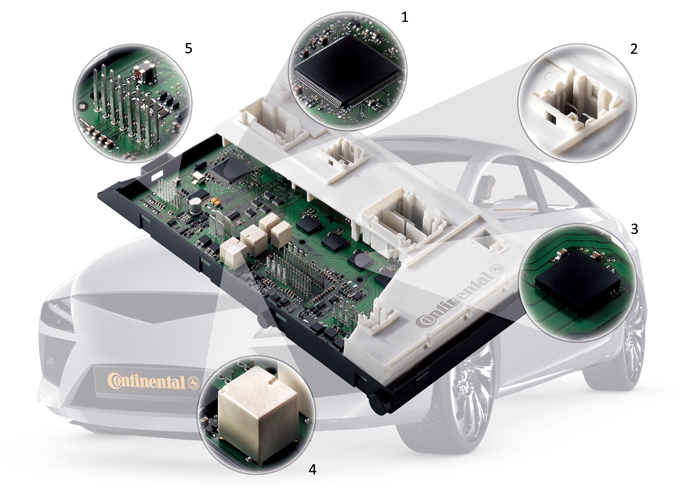
TRW Outlines Trends for Electronics Growth
TRW Automotive Holdings Corp., one of the top-10 automotive suppliers, recently claimed that it expects pressure from legislators and consumer groups to make cars safer to push several notable trends in the automotive electronics field including: the mainstreaming of crash avoidance technologies; focus on affordable radar and camera systems; and increased demand for open-architecture systems.
Peter Lake, executive vice president for sales and business development at TRW, stated: "Electronics is the fastest growing automotive commodity: industry estimators now place the percentage of a vehicle's cost attributed to this area to be as high as 40% to 50%, up from 20 percent a decade ago."
Lake said that the industry is stepping up to the mark as organizations such as the World Health Organisation and the European Commission have set ambitious targets to drastically reduce the number of road fatalities globally by 2020. To support this, New Car Assessment Programs (NCAPs), including Euro NCAP, are revising their rating programs to reward and promote safety improvements in new vehicles over the coming years. One of the most important goals of the new scheme will be install emergency crash avoidance technology, which will significantly boost the electronics content of new vehicles.
With driver assist systems (DAS) set to enter the mainstream, TRW expects that optimizing costs will become an important topic for vehicle manufacturers and suppliers. In order to support the growing demand for video and radar, TRW is working with its customers to bring new, advanced safety technologies to market at an affordable price.
TRW says that with a number of its safety systems including airbags and slip control systems, TRW has a track record of designing and engineering affordable technologies. To achieve this, for example, the company needs to think about the technological evolution of a product right from the start—considering how technical advances and manufacturing process improvements can allow us to bring a product more affordably to market, but with the same performance.
Finally, TRW is seeing a clearer trend toward domain architectures and a greater demand for open system architectures in order to address the growing complexity of vehicle electronics. TRW is a leader in this area and will start production of its "Safety Domain ECU" (SDE) in 2013 with a major European vehicle manufacturer.
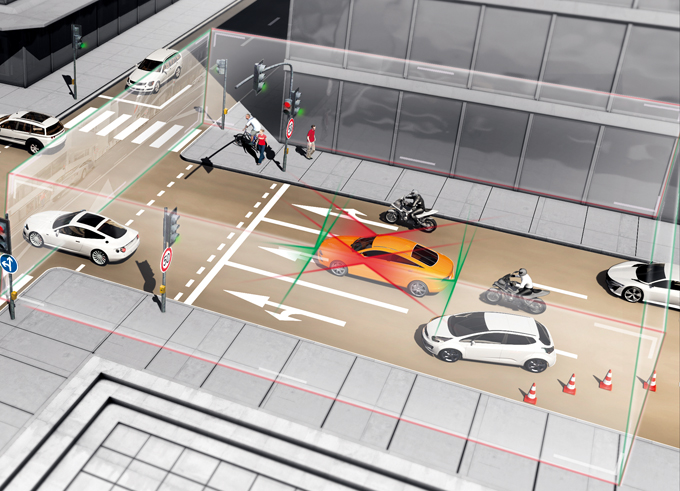
Continental's Body Domain Control Modules
Continental Automotive, another international automotive supplier, is focusing on integration of body control modules. By 2015, it plans to start mass production of a new generation body domain control module for various vehicle platforms. The high degree of functional integration will be the main difference between body domain control modules and previous body control modules.
A senior official at Continental said that future vehicle generations require electronic architectures that offer better performance and greater flexibility as the functions of automotive electronics expand. Continental aims to reduce system costs by up to 30%, in comparison to previous decentralized solutions with a greater maximum variety of functions. To make this happen, the automotive supplier is drawing on current electronics standards and the AUTOSAR architecture.
In domain control modules, Continental says, multiple, previously separate, control modules can be bundled in one highly integrated control module, bringing together control of the comfort access system, the central control module, the light control module, and even the gateway in one highly integrated computer. In this way, the central domain computer monitors and controls the vehicle's exterior and interior lights, the windshield wipers, heating for the seats and outside mirrors, the access authorization system, and internal vehicle data communication. Continental is currently planning body domain control modules with up to four microcontrollers and numerous CAN, LIN, FlexRay, and Ethernet interfaces.
Continental's ASL Vision
To further strengthen its capability in driver assistance safety systems, Continental recently also announced the acquisition of the U.K.-based ASL Vision.
With this step, Continental is enhancing its technology portfolio by adding the strategically important building block of 360-degree surround detection, while at the same time further developing its competence in the camera sector, the company says. ASL Vision has 53 employees, primarily engineers, who specialize in the areas of software, algorithms, image processing and hardware.
"Surround view" systems optimally detect the entire vehicle surrounding and are an excellent addition to Continental's ContiGuard safety concept, Continental says. ContiGuard integrates active and passive safety systems with surrounding sensors and their coordinated interactions. In particular, the fusion of radar and camera will allow new and expanded features, and it is an important prerequisite for implementing automated driving.
"By acquiring ASL Vision, we are accelerating the existing growth activities in the area of advanced driver assistance systems. 'Surround view' will also allow us to safely master complex traffic situations such as lane changes, passing other cars and challenging parking circumstances," said a ranking official of Continental. As a general rule, a "surround view" system consists of three to five cameras as well as an electronic processing unit. ASL Vision offers a range of technological solutions.
One is a camera system like those already available in the passenger vehicle sector, with a display feature for the camera images on the dashboard, that is overlaid with intelligent displays such as the vehicle trajectory display when driving backward. ASL Vision also has a successful system that was developed especially for the aftermarket and is already in use in the industrial sector and in mining, for instance. In the future, Continental will work on and further develop "intelligent" "surround view" systems with features such as free-space and object recognition, as well as reading curb edges for highly precise parking.
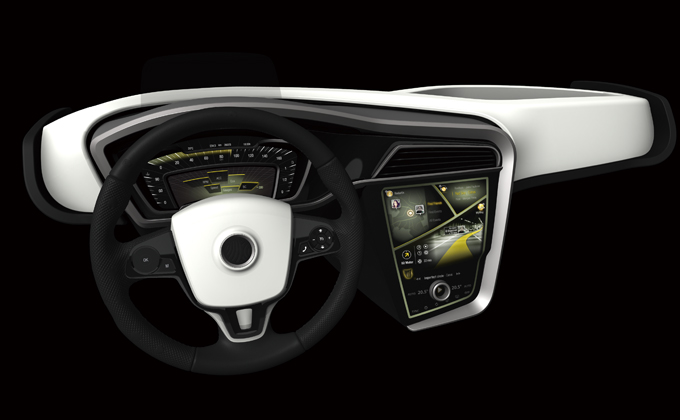
Johnson Controls Features Innovative Electronic Cockpit
To demonstrate its forward-thinking driver information innovations, Johnson Controls, a global leader in automotive interiors and electronics, showcased an electronic cockpit display at its 2013 NAIAS exhibit in Detroit.
The electronic reconfigurable cockpit demonstrates the synthesis of advanced developments in driver information with future infotainment platforms utilizing Johnson Controls' visionary human machine interface (HMI) process, the company claims.
With a seamless integration of information on three-dimension (3D) surfaces in the cluster and center-stack, the electronic cockpit also features: a reconfigurable cluster combined with heads-up display (HUD) concept utilizing one Digital Light Processing (DLP) picture generating unit; DLP HUD with wide field of view that provides improved readability due to high resolution, contrast, and brightness of the display; DLP-based projected center information display with a 2D touch and gesture control using infrared technology; flexibility for auto makers in the design and craftsmanship of cockpit interiors and electronics displays on 3D surfaces with seamless integration; and an enhanced driving experience that allows the driver to seamlessly distribute information between the instrument cluster, center stack and head-up displays.
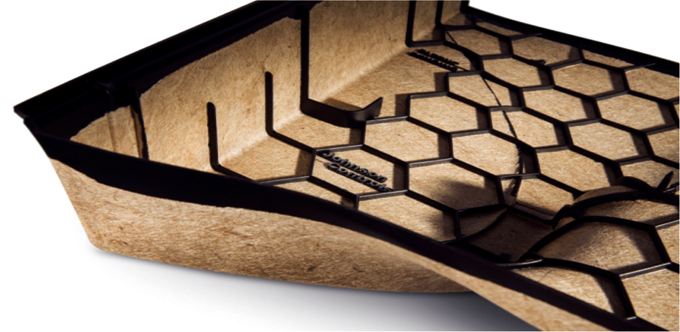
Lightweight, Renewable Solution for Vehicle Interior Components
Johnson Controls also debuted its lightweight and renewable Compression Hybrid Molding (CHyM) process technology in a door panel substrate component at the auto show in Detroit.
"With years of experience in natural fiber solutions, we continue to produce products that meet the changing needs of our customers and the industry," said Han Hendriks, vice president, Advanced Product Development for Johnson Controls' Automotive Electronics & Interiors.
According to the company, CHyM is the latest example of Johnson Controls' efforts to develop and differentiate itself in the industry through sustainable and innovative lightweight technology. The CHyM process technology integrates the advantages of both natural fiber and thermoplastics, allowing these technologies to be positioned exactly where they are needed for maximum product performance. A unique manufacturing process also contributes to the overall value of CHyM.
Additional benefits of the process technology include a 40% weight reduction compared to traditional polypropylene; an increase in stability through the combination of natural fiber and glass-filled polypropylene. CHyM provides among the highest strength-to-weight ratio when compared to products in the same cost category, a 30% increase in product stiffness and improved assembly to the body-in-white and part-to-part craftsmanship.
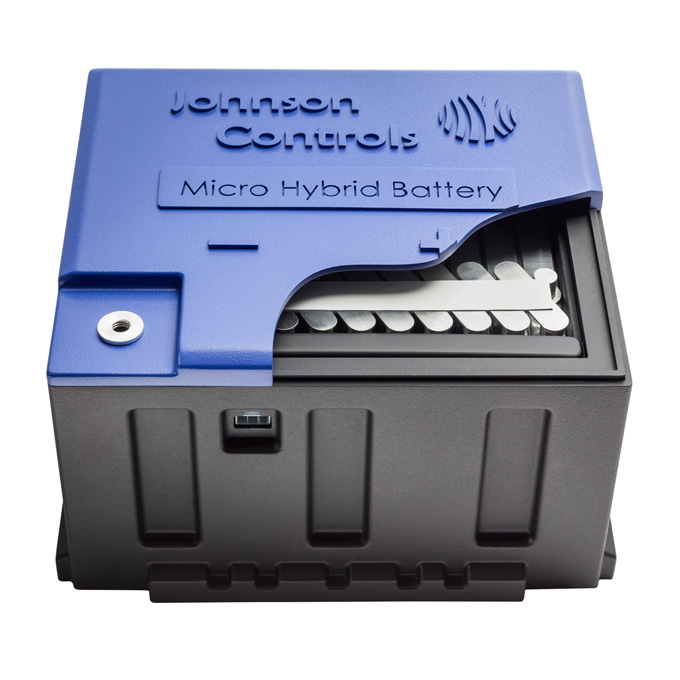
Micro Hybrid Battery Demonstration Module
To meet the increasing demand from current market, Johnson Controls also introduced its 48-volt Micro Hybrid battery demonstration module as part of its full spectrum of advanced energy storage solutions for automobiles.
Leveraging a dual-voltage architecture, Johnson Controls' Micro Hybrid battery system would involve a low voltage lead-acid battery and a 48-volt Lithium-ion battery that enable optimization of energy generation and consumption, thus saving fuel.
In prospective development programs with key automakers, the 48-volt battery could support higher power loads such as electric air-conditioning, active chassis technologies and the capture of direct regenerative power energy braking. The 12-volt battery would continue to provide power to the vehicle starter, interior and exterior lights, and entertainment systems such as radios and DVD players.
The company says that it expects such technology to be adopted in Europe first, due to more stringent fuel economy and emissions standards, and then quickly move to U.S. markets in the next few years with mass adoption by 2020.
Harman Shows Premium In-Car System with ADAS & Entertainment
Harman, the parent company behind an array of legendary brands that includes AKG, Harman Kardon, JBL, Mark Levinson. Lexicon, Infinity and more, unveiled a new premium infotainment concept combining advanced safety and entertainment innovations: interactive HUDs with augmented navigation, touch-free gesture controls, and the latest connectivity options.
The new infotainment concept from Harman uses the latest in seamless connectivity solutions such as 4G/LTE to link navigation data with a variety of external data to offer the driver more safety data and driver assistance features. The concept is based around a "multi-display" concept, where the in-dash center console, instrumentation cluster, and HUD are fully integrated.
The multi-display concept takes the breadth and depth of information available to a driver to a new level and makes driver interaction safer than ever. Harman's augmented navigation creates a "virtual reality" guidance experience, projecting guidance aids such as upcoming exits, signals, or collision warnings onto the windshield.
The unit includes advanced safety features to enable the vehicle to interact with its driver via the head-up display – for example, giving the driver an instant, un-missable cue (visual, audio or both) that the vehicle is leaving its lane, or that there is another vehicle in the driver's blind spot. All this information is projected directly into the driver's line of vision via the HUD – the eyes don't have to leave the road, and thus don't have to change focus. Operation of the unit is totally touch-free.




